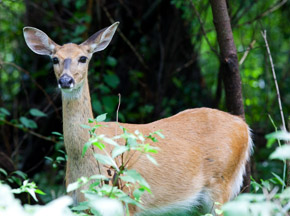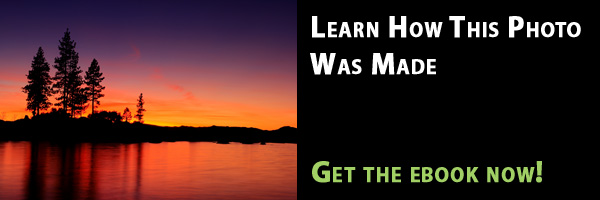
Well, a few weeks ago I took a survival training course and learned something that might increase your chances of spotting some wildlife:
Many animals are highly active immediately before and after a storm.
Or, more specifically: animals become more active whenever there’s a sudden change in barometric pressure.
So, if you go out hiking right before (or after) a big storm, you’re much more likely to see wildlife. Many animals are moving around at this time so they can find better shelter for the coming storm. Somehow, they can sense that a storm is coming.
I don’t encounter many storms here in southern California, but I remember a couple years ago when I was in the desert right before a huge storm rolled in. I remember seeing a ton of wildlife that day, including a large group of short-eared owls.
Of course, storms always come with thick dark clouds, so if you choose to photograph wildlife before or after a storm, you’ll have to deal with some low light conditions (try increasing your ISO to 400 or 800, and use a wider aperture).
But, storms also come with interesting lighting conditions for landscapes (especially when the Sun finds a way to sneak through some of those thick dark clouds). If you’re lucky, maybe you’ll even get to capture a rainbow.
So, next time a storm rolls into your neighborhood, don’t cancel your hiking plans! It might be a great time to spot some wildlife and catch some dramatic lighting for landscapes 🙂
As always, please be safe though. Respect wildlife, and prepare for any inclement weather (especially flash floods, which can be much more dangerous than they look).
Btw, if you’re interested in taking a survival training course, I can highly recommend Tony Nester at Ancient Pathways. I’ve read a few of his books (which are also great), and I just took his 3-day “complete survivor” course, where I learned a ton of useful information about making fire, procuring and preserving food, tracking, and more.
What did I miss?
If you have another tip for spotting wildlife, please share it with us by leaving a comment below. Thanks! 🙂
Get more great tips in our free weekly newsletter.
 About the Author: Steve Berardi is a naturalist, photographer, software engineer, and founder of PhotoNaturalist. You can usually find him hiking in the beautiful mountains and deserts of southern California.
About the Author: Steve Berardi is a naturalist, photographer, software engineer, and founder of PhotoNaturalist. You can usually find him hiking in the beautiful mountains and deserts of southern California.

Birds are often very active after storms or during breaks in storms. Look for small flashes of light/dark in trees or on the ground and it is likely to be birds preening their feathers to get dry and warm again. Also, they do not have much fat reserves, so if it has been raining for several days, the birds will take every chance they can in breaks between the rain to eat and they are often so hungry, they will ignore you if you don’t get too close.
A teacher of outdoor skills told me that if you want to observe animals in a wilderness setting, try sitting quietly for at least 15-20 minutes; preferably not moving at all (it’s really hard but with practice you can do it). Animals respond more to movement than physical stature. Avoid strong scents (colognes, aftershave, perfume, etc), sit quietly and just observe (camera ready, in quiet mode). If possible, observe where animals feed and anticipate their presence having camera on tripod at the ready. Try this tactic at home or at a park near where birds congregate; sit quietly and wait for their return to normal activity.
I will reading about the subject I want to photograph , like breaking seasons ,food source for that time of year .Water holes are a good draw for all types of animals . Patients and lost of it,
Great tips! Where I live in central Florida we experience many thunderstorms and it’s very important to research lightning safety information prior to heading outdoors. Since the impending rain causes small mammals and insects to move to higher ground, just before a storm is a terrific time to spot raptors in action.
I really enjoy your site, Steve! – Wally
I find it handy to talk to hunters. They know the area, and the habits of wildlife. During the off season, they are often a valuable source of information.
Fantastic tips! All of you have shared wonderful ideas that are true and definatly do work. I have found that by living in Clearwater FL we do get a lot of opportunities for taking wildlife. We’ve had a rainy summer and the wildlife loves getting active after the storms. . (sometimes even during them) I have found that whenever you decide to take wildlife photos patience, persistance and being prepared and a must. Move slow and be mindful of them. There are times I will even make some bird calls and then watch their expressions. That is a great time to capture them as they respond to youe sounds. In any caes be still & still initially. Be patient, be persistant and be prepared to capture great shots. Good luck to all, and have fun while your at it.
When approaching any wild animal or bird, do not walk “directly” toward them but off to one side. Avoid eye contact as much as possible and a slow steady motion is always better than any jerky motion or stopping and starting. Also avoid wearing any white clothing, white is the “alarm” signal for most all wild animals. I have seen that even wearing a pair of white socks at times with long pants and loafers have spoked birds where removing the stupid socks actually made the difference. But of cours the number one tip on seeing wildlife, is you have to be out there, irregardless of weather you can not spot them sittng on the couch watching TV!!